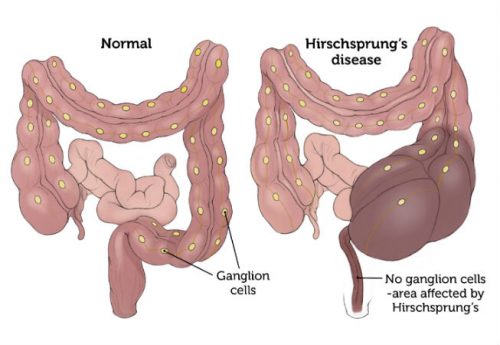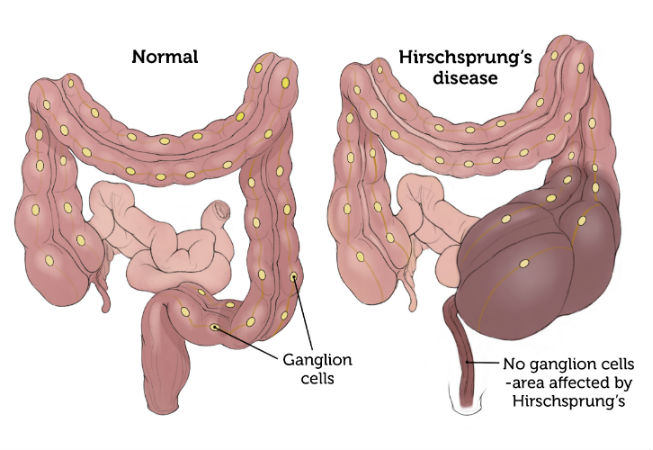
Hirschsprung’s Disease: Cause, symptoms, Treatment
There are some babies that when they are born, for a long time after birth, they would have problems in defecating. This is Hirschsprung’s disease. It is a condition that is present at birth, and is due to some missing nerves from the muscles of the baby’s intestine (mostly large intestine). babies with this condition would have difficulty passing stool within 48 hours after they are born. some others may have a swollen stomach or vomiting.
What is Hirschsprung’s disease?
Hirschsprung’s disease is a condition that affects the intestine (where the food we eat passes through and is absorbed into our body), which brings about difficulty in bowel movement and movement of the food we eat.
It is congenital, that is to say, it is present when the child is born. It usually affects the large intestine but can also affect the small intestine too depending on severity. It results from absence of nerve cells in the intestine as a result they cannot move the food that is inside them downwards to the anus.
What causes Hirschsprung’s disease?
As already stated, it is the absence of nerve cells in the intestine. The exact cause of this absence is not known but many theories have been proposed.
Nerves are like an extension of the brain and spinal cord through which they control the activities of different part of the body. Hence, when these nerves that are supposed to be in the intestine are not there, the child would not be able to move food substances in the intestine down to the anus.
This absence of nerve happens when the child is inside the womb. It could be due to failed migration of nerve cells during development of the intestine or due to an immunologic destruction of the nerve cells. It may also be genetic or familial.
Don’t worry, just forget all this big grammar. The summary is that, the child with this condition cannot move food in the intestine down to the anus, hence, the child would have problems defecating, with constipation, vomiting, etc.

Classification of Hirschsprung’s disease
This Hirschsprung’s disease can be classified into five depending on the part and the length of the intestine that is involved. They include:
- Short Segment
- Long segment
- Total Colonic
- Total Intestinal
- Ultrashort Segment
Short segment is the most common and affects the ending part of the large intestine known as the rectosigmoid colon. The least common is the total colonic.
Risk Factors for Hirschsprung’s disease
These are the factors that may increase the risk of having this Hirschsprung’s disease. They include:
- Hereditary: It is observed that when there is a family member that has had the disease, other members have a higher risk of having it. read more about genotype here.
- Gender: It is found to be more common in Males.
- Presence of other inherited conditions.
- Race: People of Asian-American origin are three times more likely to have the condition.
What are the symptoms of Hirschsprung’s disease?
Symptoms result from absence or reduced bowel movement. They include:
- Failure to defecate or pass stool: This is usually first noticed when the baby is fails to pass the first stool after birth known as meconium.
- Chronic constipation: The child would have problems with defecation.
- Vomiting: Once the food eaten cannot go down, it would most likely be coming up instead, and the child would be vomiting anything you give him/her.
- Poor feeding: When a child is always vomiting, the child would find it difficult to eat.
- Failure to thrive: a child who does not feed well would not grow well. That is what we refer to as failure to thrive. This means there is absence of corresponding growth and weight gain as baby gets older. Baby will usually be small for age. This means, when you look at the average children that is at similar age with him/her, they would be much bigger.
- Signs and symptoms of malnutrition can set in. Baby can develop anaemia, nutritional deficiency diseases, recurrent infections due to poor immunity, etc. See more on malnutrition here.
- There may be abdominal distention due to accumulation of faeces. The faeces is hardened over time. This is known as fecaloma.
- Dehydration: The child would be looking very dry.
- Bowel can get perforated and an infection of the intestine (enterocolitis) and intestinal cavity (peritonitis) can occur.
Hirschsprung’s disease may be associated with certain disease conditions and syndromes. It can occur together with Down syndrome, bowel atresias, anorectal malformations and neurocristopathies.
Diagnosis
A diagnosis of Hirschsprung’s disease is made by a doctor based on clinical evaluation and tests that will be carried out. If the symptoms listed above are noticed, the child should be taken to see the doctor at once. The doctor specially trained to manage this condition is called a Paediatric Surgeon. However, doctors from other specialties may be involved.
The doctor will ask you questions about the symptoms experienced by the child. An examination of the child’s body will also be carried out after which some tests will be done.
Some of the tests include; An x-ray of the abdomen, A biopsy of the bowel (rectal biopsy), etc.
Other tests may also be carried out to check the general condition of the child and know whether the child is fit to go for surgery. Examples of these tests include: serum electrolytes, urea and creatinine; full blood count and chromosomal studies.
Treatment for Hirschsprung’s disease
The main treatment for this condition is surgery. There are different kinds of surgeries that could be carried out to correct this disorder. Surgery is done to bypass the part of the intestine lacking nerve cells.
The two main ones are what we call: a diverting colostomy or ileostomy and a pull through surgery.
Medical treatment is also administered to optimize the patient and correct any complications and derangements arising from the disease such as dehydration, malnutrition, infections and other related derangements.
Complications of Treatment and Prognosis
Complications like persistent constipation, Hirschsprung’s associated enterocolities, anastomotic leakage and persistent soiling may arise from surgery. Surgery, however, is usually successful with good outcome when done by a specialist in 90% of cases. About 1% of children develop incontinence and will need a permanent colostomy as a result. A permanent colostomy is a permanent sack put on the abdomen that collects faeces.
Poor outcome occurs in Hirschsprung’s disease associated with chromosomal abnormalities and genetic syndromes.
Leave a reply
Leave a reply